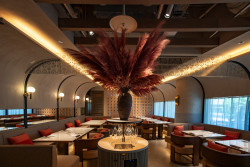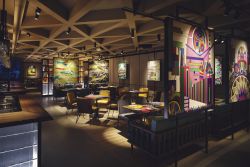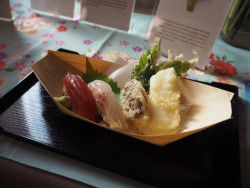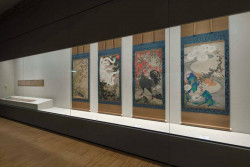
February 2, 2006
The View From the Hills
Minoru Mori defends the Omotesando Hills development and reveals big plans for Tokyo
By Metropolis
Originally published on metropolis.co.jp on February 2006

Photos by Nathan Shanahan
Tokyo Midtown Project, Akihabara Crossfield and a gaggle of new skyscrapers in Marunouchi are just a few of the major redevelopment projects, driven mainly by private developers, that are soon to come to completion. More are on the drawing boards. These mega-projects don’t only change the geography of the areas they sprout from; they also change their character. Omotesando Hills offers a model in miniature of the implications.
Omotesando is a very special street. The broad, tree-lined boulevard originating at the gates of Meiji Shrine is Tokyo’s premier urban catwalk. In recent years, it has become a glittering necklace given by Architecture to Fashion as a token of their glamorous international romance, studded with the contemporary jewels of the houses of Prada, Tods, Dior and Louis Vuitton. Take a few steps off the leafy sidewalks and you enter an intricate maze of tiny streets threading through a tissue of residences and small offices, sprinkled with a delightful variety of boutiques, restaurants and galleries. The atmosphere is cultured, unsullied by snobbery, creative but comfortable, intimate yet open. It is arguably the best setting for a contemporary urban lifestyle that Tokyo has to offer.
Within this neighborhood, something new and different has emerged. For the past two and a half years, shielded for much of the time behind the vertical turf of a plant-covered construction hoarding, Omotesando Hills has been climbing out of its deep hole in the ground.
The structure is far bigger than its streetward guise suggests, with half its 12-story bulk buried underground. It is the offspring of a consummation between Tadao Ando, undoubtedly Japan’s most famous living architect, and Mori, the powerful developer and self-described urban visionary behind Mori Building Co. Big, long and very imposing, it is also, in true Mori form, highly controversial.
In October, this journal published an attack on the development. Calling it “one of the cruelest pieces of architecture this city has seen,” Metropolis publisher Mark Devlin, an Omotesando resident, slammed the building and lambasted Mori for creating soulless environments that are “all noise and no content.” The article sparked a loud response from readers, many also critical of the building, some taking the opportunity to raise concerns about the jewel in Mori Building’s crown, Roppongi Hills.
As Minoru Mori prepares to open the doors of Omotesando Hills next Friday, Metropolis asked him to explain his vision for Tokyo.

Minoru Mori
What contribution do you want Omotesando Hills to make to the Jingumae area?
I hope that with this project the local area will exceed Ginza as a shopping area and become recognized as a center of fashion and art not only in Tokyo but in Japan and throughout Asia.
How does that fit in with Harajuku’s position as an international center of youth fashion and culture?
When I completed Laforet (built and owned by Mori Building), Harajuku wasn’t considered a big international-standard center of commerce or fashion. But after that, many brands started to open shops along the street, including Hanae Mori and Comme de Garçons—all the big names from the fashion world. However, it was an aggregation of individuals and somehow it lacked a core to attract people from all over the world, so I hope that Omotesando Hills will become such a core attraction. It’s going to be the eyes of the dragon. We say that when you draw a dragon you start with the head and body and only at the very end do you draw the eyes to complete it.
What efforts did Mori Building make to preserve the spirit of the old Dojunkai apartments?
The Dojunkai apartments epitomized the history of modern architecture in Japan. Omotesando was the first boulevard to be built in Japan. After the Great Kanto Earthquake people realized that we should build strong apartments to withstand such natural disasters, and these were the first such apartments built using cutting-edge technology of Japanese architecture at that time, and they became the model of all the other apartments in Japan.
By the end of the war the apartments remained but the torii gate to Meiji Shrine was burnt down. Later with the construction of Washington Heights (in what is now Yoyogi Park) it became the leading center for the introduction of American culture. It was in this atmosphere that the Dojunkai apartments became a sort of elite place to live, and they had an emotional attachment and history. Many people wanted to keep the apartments as they were, but it was decided to redevelop the whole area, so we wanted to create a new tradition to make it a convincing success.
When the old apartments were demolished there were 140 units, only 10 percent of which were being used as residences. Many were shops or other retail-related facilities and many were vacant. The buildings also faced possible collapse in the event of a major earthquake. They had faced the normal wear and tear over the years. Their seismic resistance wasn’t up to modern standards, and it was dangerous to leave them as they were. Some owners still wanted to keep living there as they were, but after the Great Hanshin Earthquake of 1995 many realized that they needed to move on and agreed to the redevelopment scheme. So it’s an uncanny coincidence that this site was built because of one earthquake and demolished because of another. The apartments were built in 1927 and knocked down in 2003, so they were in service for 75 years. Usually the average lifespan of a building in Tokyo is 25 years, so this is three times the average and about the same as London, I think.

Tadao Ando
How and why did you select Tadao Ando as the architect?
I thought we needed someone of Ando’s magnitude, a world-leading architect, to get wide support for the project.
In many countries, when a sensitive site is being redeveloped there is a public-tender competition process to facilitate public dialogue about the outcome. Why hasn’t Mori Building taken this approach?
No we haven’t taken that approach before. We choose our architects according to the specific site, environment or purpose of the development. But of course we have a very heated discussion internally before making a final decision, and we have a process of discussing these matters with landowners affected by the scheme and the people living nearby. So there is plenty of opportunity for these people to understand and get involved, we don’t just jump to our final decisions.
Moto Azabu Hills was designed by leading Japanese architect Shozo Uchii, who also designed the Imperial Palace. Some people think the goblet shape is rather odd, but it is quickly becoming a landmark. Atago Green Hills was designed by Cesar Pelli, and with the temple in the middle has a Buddhist theme, and the two towers resemble lotus buds about to bloom. At Roppongi Hills we employed many different architects: Kohn Pederson Fox for Mori Tower, Sir Terence Conran for the residential towers, Fumihiko Maki for the TV Asahi broadcasting headquarters, and others. I think we have been very successful choosing the best architects for the best places.
Even though Ando was a popular choice [for Omotesando Hills] there was a certain amount of opposition amongst the landowners who were concerned that his buildings were too fashionable for the area. But when it opens I think people will understand that it is going to be a site of cultural heritage for the future.
You are unusual among developers in promoting the role of “culture” in your commercial projects. Suntory Hall in the Ark Hills development of the mid-’80s and the Mori Art Museum atop Mori Tower are the two most celebrated examples. What is the function of culture in your developments?
The cities of the past were industrial cities, but today we need cultural cities that are international, comfortable to live and work in, and also fun to visit. I believe that only those sort of cities will thrive in the future. That is why I wanted Roppongi Hills to be the cultural heart of Japan. Ark Hills was mainly a financial center with a cultural aspect on the side, but at Roppongi Hills, culture is at the heart of the project.
In your Urban New Deal proposal for regenerating Tokyo, you say that you want to redevelop the whole city. Aren’t there any areas of Tokyo that you would keep as they are?
Since Roppongi Hills was completed, the adjacent areas have changed too, and this also would be true for other developments. I’m thinking about building five more Roppongi Hills-style developments in Tokyo in the next 15 years or so, and so those neighboring areas will inevitably change too. I’m not sure what will remain. The things I would like to keep are parks or historical sights—shrines and temples. But as for other residential and office areas, there is none that I would keep as they are right now.
Which areas of the city are you looking at for these new Roppongi Hills-style developments?
The NPO Council is now being established to debate and lay a plan for the redevelopment of central Tokyo. If they ask Mori Building to undertake any schemes, it should be around here, namely in Minato Ward. Governor [Shintaro] Ishihara has started planning a bid for the 2016 Olympics more than 50 years after the last games here in 1964. In bidding for the games the council wants to change the main street layout and infrastructure of Tokyo, and anything Mori Building does will fit into that citywide plan.
Even if we don’t get the Olympics we may have a major earthquake, so we need to rebuild the city sooner rather than later. This is the most important point. We shouldn’t just make Tokyo earthquake-proof by using the latest technology such as base isolation systems and vibration control systems. Tokyo shouldn’t be somewhere people need to escape in an earthquake but somewhere that can protect them, and where daily life can continue if it happens.
Roppongi Hills is the showcase for the concept you call “Vertical Garden Cities.” Is there anything you would change if you were building another Roppongi Hills-style development again?
Roppongi Hills isn’t the best we can do, and of course there are many things I would change if we did it again. But each site has its own specific requirements. In the case of Toriizaka, neighboring Roppongi Hills, if we develop that area it will be different, more multi-layered with retail and entertainment at the bottom and something more academic above, such as Toyo Eiwa school or The International House, both of which are there right now. And any residences or hotels on the site would also be different. And in the case of the Kanjo Loop Road No. 2 project, we plan to have buildings straddle the street. At Roppongi Hills we built Roku-Roku Plaza over the street, but for this project we are going to see a building actually above the street for a more efficient use of the area.
Mori Building’s website states: “Our mission is to create cities, and to nurture those cities together with their residents and other people who use them. In other words, we aim to be involved with almost every aspect of human life.” Why didn’t you choose politics as perhaps a more appropriate path to achieve your goals?
Politics is not my strong point. Personally I think the academic field needs more attention right now, and I have become a visiting professor at Tokyo Shuto University in order to prevent the spread of wrong ideas about city planning. So I would like to play a role in that area.
And finally, a lighter question—one that everyone would like to know the answer to: Why do you name all of your developments “Hills”?
Tokyo is roughly divided into the Shitamachi downtown area and Yamanote hillside area. Our recent developments are on the Yamanote side and often have slopes and hills as part of their geography. In the case of Omotesando Hills, it’s built on a slope but also it has an ascending spiral “hill” inside as well. And of course there are wonderful places around the world such as Beverly Hills which give the name a nice connotation. Perhaps I should change the name of the company to Mori Hills, too.

Omotesando Hills is overshadowed by fond memories of the shambolic dignity of the old Dojunkai apartments. By the time of their demolition in 2003 the apartments were widely loved, by architects (including Tadao Ando) and the broader public. Built in 1927, they held great significance as architectural heritage, being one of the last remaining examples of the innovative concrete apartment buildings built by the Dojunkai, or “Mutual Prosperity Association,” a socially progressive organization formed to assist the re-housing of residents made homeless by the great earthquake in 1923. In their ivy-clad autumn years, the buildings provided an evocative link to the allure of Tokyo in the ’20s, an optimistic time when reconstruction of the city was conducted in the context of a thrilling vivacity of modernism in the arts and democratic ideals in public affairs.
As Aoyama changed over the decades from a quiet residential district to a hub of creative energy, Omotesando increasingly became host to major fashion brands and their flagship buildings. But the old apartments stayed, moldering charmingly away, immune to the sterilizing impulses that money always seems to bring to urban environments. Their occupancy was not static, however, evolving from housing towards more socially interactive uses such as quirky boutiques and small galleries. The content evolved while the form endured, and it was the limitations of the form (small spaces, grungy materials) that helped keep the content local and distinctive—an antidote to the luxurious preciousness of the global fashion brands. The length of the apartment buildings’ frontages along Omotesando guaranteed that their piquancy would stay an intrinsic part of the atmosphere of Omotesando, regardless of what happened around them.
That this situation was unsustainable is obvious. Eventually, the physical decay of the fabric of the building, combined with the rising commercial value of the location and the anachronism of the accommodation standards in the apartments, would force some form of action. The question was, what action? Preservation was the favored option among many architects, including Ando, but this proved, in his words, “neither physically nor economically viable.” Indeed, in discussing his approach to the design of Omotesando Hills, Ando appears haunted by the loss of the Dojunkai apartments—a building that he regarded as a masterpiece—stating that “our main task was to decide how this magnificent urban heritage should be preserved.”
It seems that redevelopment was the only path forward. But this assertion remains questionable, as preservation, conversion and reprogramming of accumulated heritage has become a common strategy for urban regeneration in cities around the world. The real issue was a lack of money to fund such an approach, which is a symptom of a lack of will and imagination. Love notwithstanding, the Dojunkai apartments were simply demolished because no one involved could justify the cost of keeping them.
Dr. Julian Worrall is an Australian architect affiliated with the University of Tokyo who works for Klein Dytham Architecture.







